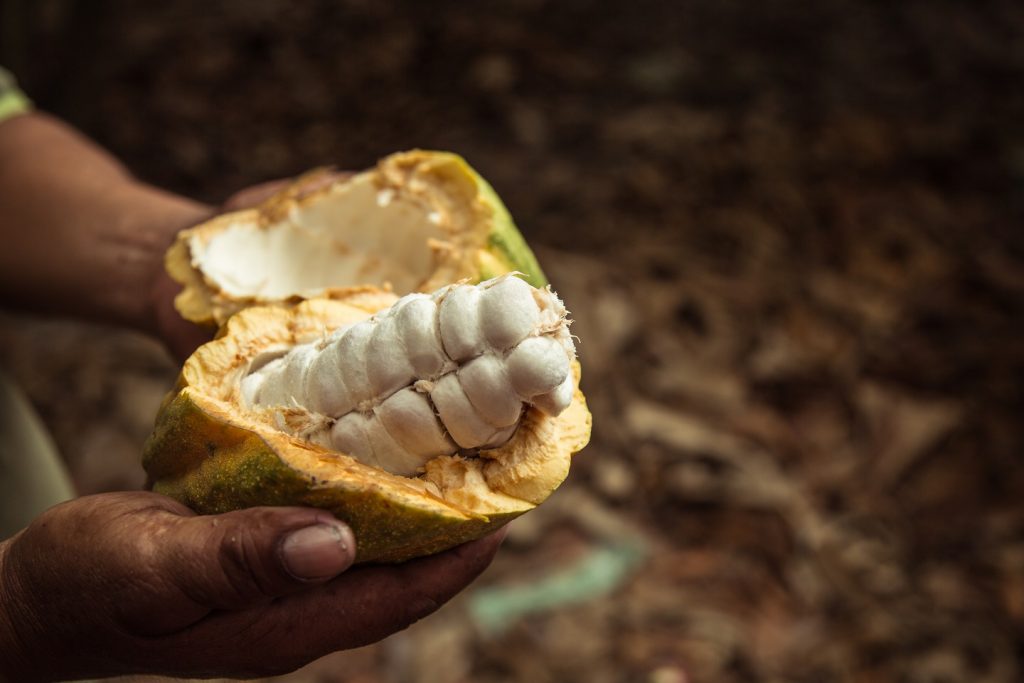What is Bean to Bar Chocolate?
Craft chocolate makers have control over the whole process, from the beans to the finished chocolate bar. They carefully source cocoa, ensuring they select the best quality raw ingredients, and that farmers are paid fairly for their work.
They often make single origin chocolate bars, where cocoa from a specific area, even a particular farm, are used in a bar.
Beans from each origin will have specific characteristics, which the makers will attempt to bring out in the final product by controlling the process.
While industrial chocolate tastes flat and lacks provenance, bean to bar chocolate contains a multitude of flavors and stories.
Each maker will have a different approach, and use different equipment, but the steps in the process are largely the same.
Harvest
The cacao tree (Theobroma cacao) grows in tropical climates throughout the world.
The fruit, which is called a pod, grows directly from the trunk and contains 20–60 cocoa beans, enclosed by pulp.
Picking is usually done with a machete, and great care is needed to ensure that the flower cushion on the tree is not damaged so that more pods can grow in the future.

Fermentation
After the cocoa pods are opened and the beans are exposed to oxygen, fermentation begins. The beans are mixed or turned to enable this process and the temperature naturally raises to 40-50°C. This stage is a major factor in developing flavour and can take up to eight days, depending on the bean type.
Drying
Following the fermentation stage, the beans contain a high level of moisture, which needs to be reduced. In most origins, cocoa beans can be sun-dried. In wetter climates, this is not possible however, so alternative methods are used, such as drying over open fires.
Shipping
The beans are bagged before being shipped to chocolate makers. Some chocolate companies make their chocolate at source where it grows, ensuring greater returns for the local economies. The hot climate required to grow cocoa does however make the chocolate making process more challenging.
Sorting
On arrival at the chocolate makers, each bag of cocoa beans must be sorted to eliminate any beans that do not meet quality criteria – those that are flat, broken or sprouted.
Roasting
Beans are roasted in small batches to temperatures and times that are appropriate for the particularities of each variety and each harvest.
The process and equipment used to roast the beans vary from chocolate maker to chocolate maker. Some use standard ovens, others have specially made systems designed to rotate the beans and roast as evenly and as possible.
Winnowing
Winnowing is the process of taking the shells off of the beans. The bean shells are delicately broken before being separated from the seeds.
What is left over is the “nib,” the most desired part of the bean.
Grinding
The nibs are then ground, either by machine or between two stones. A liquid mass called cocoa liquor, or cocoa mass is produced.
Conching
Conching is the process of mixing the cocoa mass. It is continuously mixed at a certain temperature to develop flavour, remove moisture and break down large pieces. This can take hours or days, perhaps up to five days, depending on the desired outcome. Grinding and Conching are commonly combined into one with the use of a melangeur.Tempering
The next step is tempering. The chocolate is slowly heated and cooled, allowing the cocoa mass to solidify and stabilize. Without tempering, the chocolate would separate and would not harden well; it would be likely to bloom.
Moulding
The final step is to put the liquid chocolate in to a mould. The chocolate is usually agitated to remove any air bubbles.
Once cool, the chocolate can be removed from the mould and wrapped.
